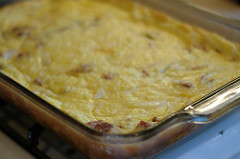A Lotta Frittata

Photo by Melissa Schneider.
My father and mother, who shared cooking duty in our home, influenced my cooking style in different ways. From my mother, I acquired a love of the elegant: tarts, soups with swirls of crème fraîche, and planned platings. From my father, I acquired a taste for improvisation, ingredients and techniques sifting though my head like pachinko balls and producing something better than I expect. Each of them could work in the other's style, but my parents, in my memory, gravitated toward those differences.
So perhaps it's appropriate that I had to improvise a dish for my father's 60th birthday, the Monday of a weekend-long family celebration. He had rented a house in Cayucos, a small coastal town near Hearst Castle, and a week before Melissa and I drove down Highway 101, he called and asked if I'd make breakfast for the 12 celebrants.
I steered towards a frittata, a flat omelette that's baked in the oven and not on the stove top. I don't know that anyone would label my inch-thick sheet of fluffy, cooked eggs a frittata, but my family loved it and asked for the recipe. Of course there isn't one; I made up the dish on the spot. But I based it on techniques that I've used dozens of times. You probably have, too.
I cut two large onions in half through the poles, peeled the hemispheres, and sliced them into longitudinal arcs, from edge to center. I melted most of a stick of butter in a pan, and added the onion curves, reducing the heat to very low. I let the onions wilt, but not caramelize, while I worked on the rest of the dish, about 30 minutes.
I sliced my ham, a Fatted Calf petit jambon, into thick pieces and heated some oil in a pan. I crisped the thick ham slices, two at a time, and sliced them horizontally and vertically into rough squares. (If you're not using a beat-up nonstick pan in a rental house, be sure to degrease and deglaze the pan with white wine, letting it reduce to a syrup and adding that to the eggs as well).
Finally, I whisked 24 eggs and added a splash of milk, a few pinches of salt, the ham squares, the onion arcs, and 3/4 pound "Swiss cheese," one of three options at the Cayucos market, a glorified convenience store. I buttered a 9" x 13" baking pan, the only item we could find that would hold the mixture, and put it in the oven. I could tell you that I cooked it at 350° but that was more of a starting point. I increased the temperature a little more each time I checked the "frittata," ending at 425° about 40 minutes after I put it in. I took the pan out when the egg mixture was solid around the edges but still jiggly, not sloshy, in the center. Just as you do for any egg dish.
The result was a pillowy brunch item that we served with sausage and a simple fruit salad. I worried that I had made too much, but my teenage cousins—and their younger sister, a burgeoning gourmet—polished off the last few pieces.
Wine Notes
As soon as we finished brunch, we all set out for three hours of driving. But if I had served wine, I would have chosen a sparkling wine made in the Champagne style. We were celebrating, after all, and the bubbles add body that can stand up to the richness of the eggs, while the acidity cuts through the tongue-coating fat. The dish has similarities to Quiche Lorraine, and the regional pairing of Alsace Riesling or Pinot Blanc would also provide good acidity to contrast the rich egg and salty meat.
- Creamy Scrambled Eggs Recipe
I'm not the first to notice the meditative state that sometimes comes about while cooking. When you are completely focused on what you are doing it's easy to get all those pesky thoughts out of your head. But there is another mental state that...
- Hangtown Fry At Tadich Grill
San Francisco has had a wild history. It wasn't called the Barbary Coast for nothing. Brothels, saloons, gambling, opium dens, San Francisco was famous for all of that, especially at the time of the gold rush. You can still see remnants and reminders...
- Oops!
After a leisurely dinner and staying up too late watching the Emmys, I got on the computer to do a couple things before going to bed. I happened to take a look at Zarah Maria’s blog and was surprised to see her IMBB 8 entry – isn’t that next weekend?...
- Wartime Wednesdays: Eggs Au Gratin
Eggs Cooked in the Shell HARD-COOKED (Coddled)---Place the eggs in a saucepan of cold water and heat slowly until the boiling-point is reached. Set the container on the back of the stove or reduce the heat so that the water will not boil again and let...
- Bone Marrow Dumplings In Consommé
Marrow dumplings in consommé Photo by Melissa Schneider. I still remember the first time I made bone marrow dumplings, an idea from the Austrio-Hungarian cookbook East of Paris. I forgot to add eggs to bind the dumpling mixture, and the pretty...
